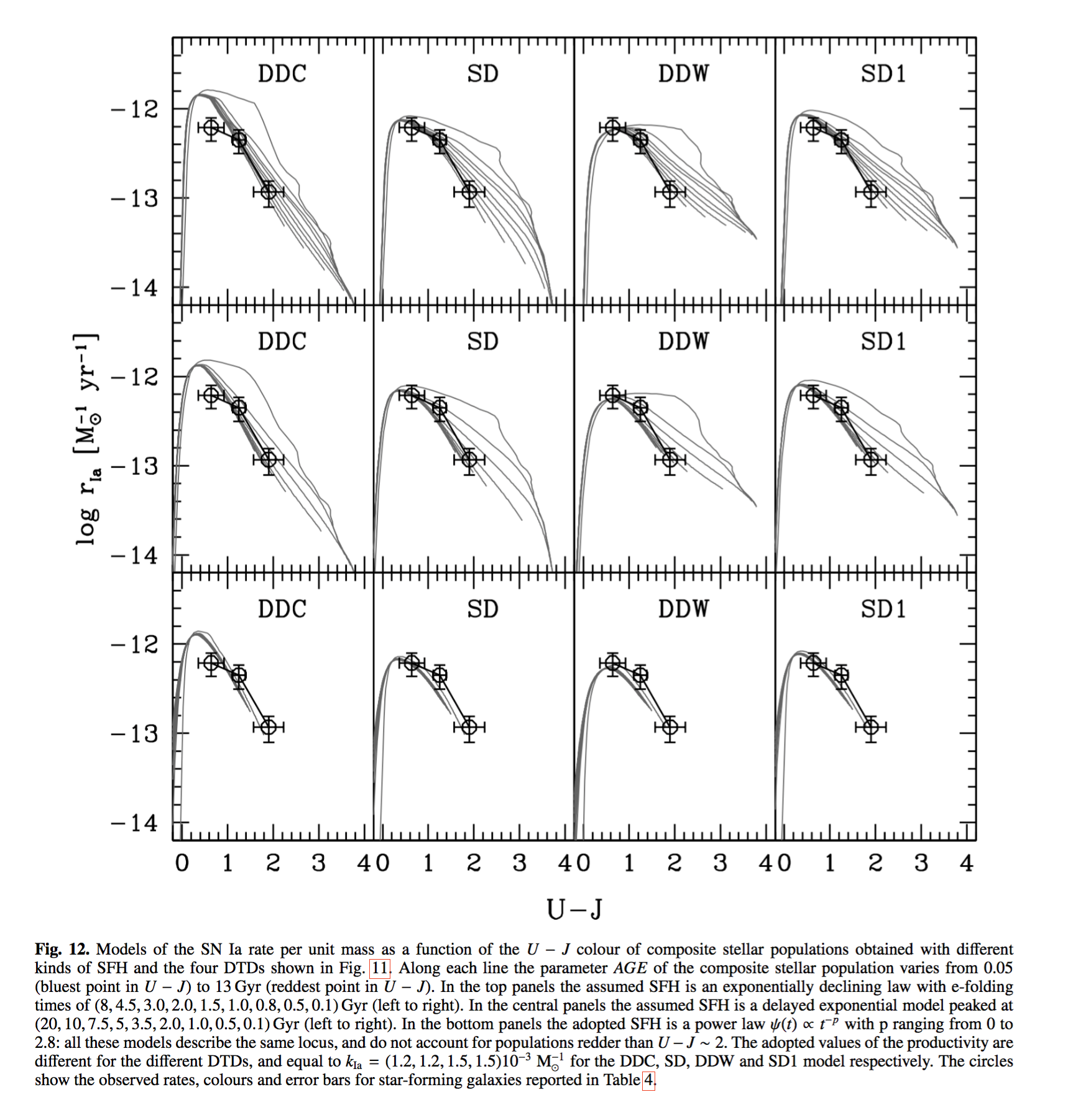Padova-Asiago Supernova Group
Highlights
Supernova rates from the SUDARE VST-Omegacam search II. Rates in a galaxy sample.
Botticella, M.T. et al. 2017, A&A 598, 50 (link to pdf)
| Aims. This is the second paper of a series in which we present measurements of the Supernova (SN) rates from the SUDARE survey. The aim of this survey is to constrain the core collapse (CC) and Type Ia SN progenitors by analysing the dependence of their explosion rate on the properties of the parent stellar population averaging over a population of galaxies with different ages in a cosmic volume and in a galaxy sample. In this paper, we study the trend of the SN rates with the intrinsic colours, the star formation activity and the mass of the parent galaxies. To constrain the SN progenitors we compare the observed rates with model predictions assuming four progenitor models for SNe Ia with different distribution functions of the time intervals between the formation of the progenitor and the explosion and a mass range of 8 40 M for CC SN progenitors. Methods. We have considered a galaxy sample of about 130000 galaxies and a SN sample of about 50 events. The wealth of pho- tometric information for our galaxy sample allows us to apply the spectral energy distribution (SED) fitting technique to estimate the intrinsic rest frame colours, the stellar mass and star formation rate (SFR) for each galaxy of the sample. The galaxies have been separated in star-forming and quiescent galaxies exploiting both the rest frame U V vs V J colour-colour diagram and the best fit values of the specific star formation rate (sSFR) from the SED fitting. Results. We found that the SN Ia rate per unit mass is higher by a factor of six in the star-forming galaxies with respect to the passive galaxies identified as such both on the U V vs V J colour-colour diagram and for their sSFR. The SN Ia rate per unit mass is also higher in the less massive galaxies that are also younger. These results suggest a distribution of the delay times (DTD) less populated at long delay times than at short delays. The CC SN rate per unit mass is proportional to both the sSFR and the galaxy mass, confirming that the CC SN progenitors explode soon after the end of the star formation activity.... 80
Botticella, M.T. et al. 2017, A&A 598, 50 (link to pdf)
| Aims. This is the second paper of a series in which we present measurements of the Supernova (SN) rates from the SUDARE survey. The aim of this survey is to constrain the core collapse (CC) and Type Ia SN progenitors by analysing the dependence of their explosion rate on the properties of the parent stellar population averaging over a population of galaxies with different ages in a cosmic volume and in a galaxy sample. In this paper, we study the trend of the SN rates with the intrinsic colours, the star formation activity and the mass of the parent galaxies. To constrain the SN progenitors we compare the observed rates with model predictions assuming four progenitor models for SNe Ia with different distribution functions of the time intervals between the formation of the progenitor and the explosion and a mass range of 8 40 M for CC SN progenitors. Methods. We have considered a galaxy sample of about 130000 galaxies and a SN sample of about 50 events. The wealth of pho- tometric information for our galaxy sample allows us to apply the spectral energy distribution (SED) fitting technique to estimate the intrinsic rest frame colours, the stellar mass and star formation rate (SFR) for each galaxy of the sample. The galaxies have been separated in star-forming and quiescent galaxies exploiting both the rest frame U V vs V J colour-colour diagram and the best fit values of the specific star formation rate (sSFR) from the SED fitting. Results. We found that the SN Ia rate per unit mass is higher by a factor of six in the star-forming galaxies with respect to the passive galaxies identified as such both on the U V vs V J colour-colour diagram and for their sSFR. The SN Ia rate per unit mass is also higher in the less massive galaxies that are also younger. These results suggest a distribution of the delay times (DTD) less populated at long delay times than at short delays. The CC SN rate per unit mass is proportional to both the sSFR and the galaxy mass, confirming that the CC SN progenitors explode soon after the end of the star formation activity.... 80
